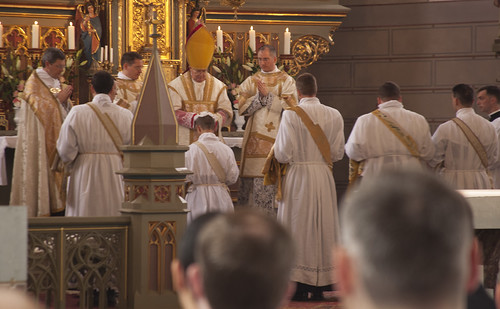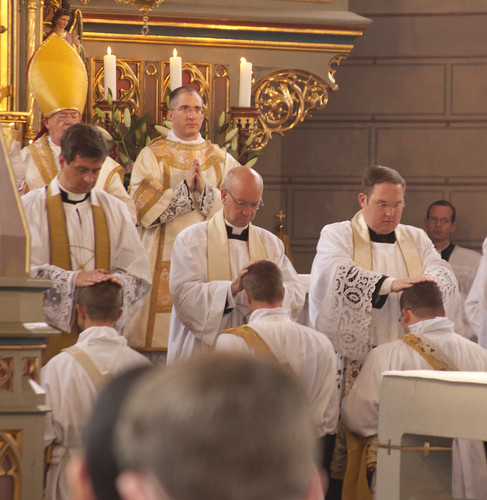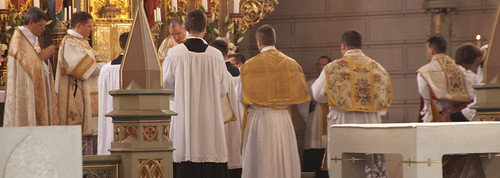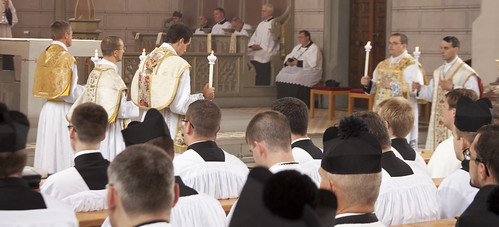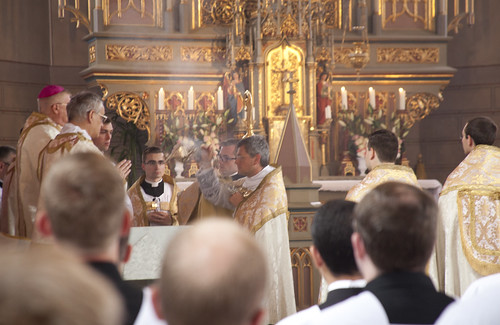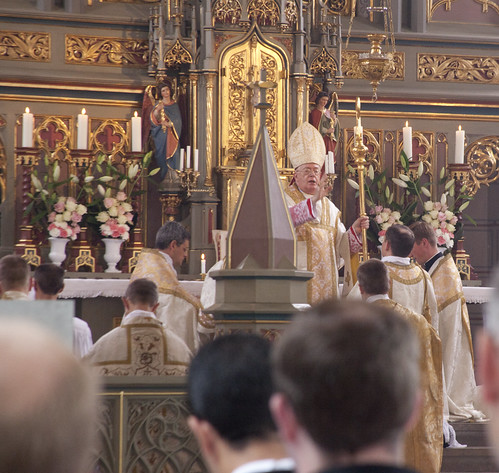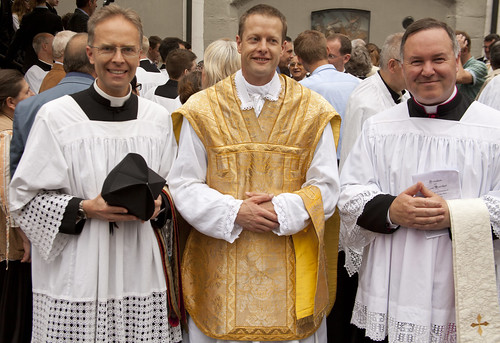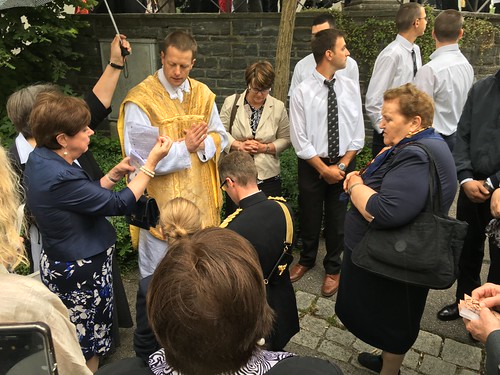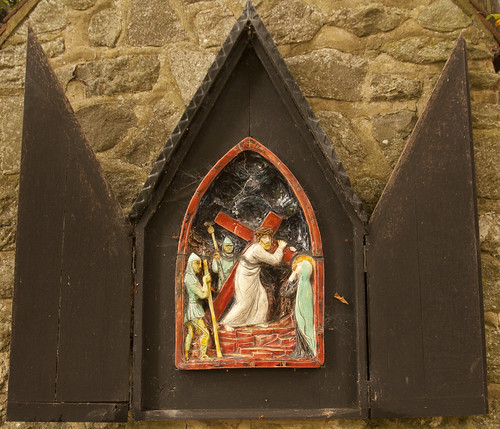Chairman's Blog
FSSP Ordinations in Bavaria
There are other and better photos around of this but I might as well put up those I have. Archbishop Pozzo, Secretary of the Pontifical Commission Ecclesia Dei, was the ordaining bishop. It took place in St Margaretas Church, Heimenkirch, not far from the FSSP Seminary at Wigratzbad.
The Church in England was well represented at the ordinations. Here Fr Bede Rowe lays his hands on James Mawdsley, just ordained. Archbishop Pozzo was assisted by two English priests of the Fraternity, Fr William Barker from Rome and Fr Ian Verrier from Reading - the latter is visible in the photo above, above Fr Bede.
Fr John Berg, the Superior General of the Fraternity, incenses the Archbishop.
Fr James Mawdsley FSSP between Fr Armand de Malleray FSSP and Canon Walsh from Preston, of the Diocese of Lancaster.
Fr James gives a 'first blessing' to his twin brother, a Lt-Col, who attended in a splendid dress uniform.
Those ordained were: Simon Grauter (from Germany), James Mawdsley (from England and Australia), Gregor Pal (from Germany), Michael Parth (from Austria), and Jakub Zentner (from the Czeck Republic).
Support the work of the LMS by becoming an 'Anniversary Supporter'.
Of your charity...
 Please pray for Anthea Craigmyle, who died peacefully, this morning, aged 83.
Please pray for Anthea Craigmyle, who died peacefully, this morning, aged 83.
She was at home, surrounded by her family.
Requiem aeternam do ea Domine, et lux perpetua luceat ea.
I will not be posting for a few days.
 |
| Feeding hens. |
 |
| The Prodigal Son. |
 |
| Tobias and the fish. |
Support the work of the LMS by becoming an 'Anniversary Supporter'.
The Traditional Mass and the Laity
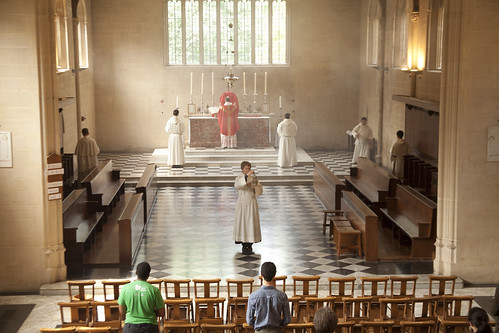 |
| The congregation is blessed with incense as the celebrant carries on the prayers and ceremonies at the Altar. Dominican Rite Mass in Oxford. |
Over on Rorate Caeli I am publishing today a Position Paper on the Laity in the Traditional Mass. It is a response to the argument that the Traditional Mass exemplifies 'clericalism', because it doesn't have swarms of lay peope in the sanctuary, reading the lessons, cleansing the sacred vessels, leading prayers and hymns and distributing communion. Read it here.
The key point of the paper is that, while at least some 'special' lay roles in the liturgy are perfectly defensible - serving and singing being the obvious examples - even these don't exist for the sake of the liturgical participation of the people doing them. This is a crucial point. Without it the rest of the congregation may well feel excluded wrongly from graces available only to the parish elite.
The situation common in many parishes, of mass involvement of the laity in liturgical functions, can lead sometimes to an unedifying competition among lay people to be involved in this way. In other cases it can lead to a frantic attempt by the celebrant or some lay side-kick to conscript lay people for these roles in the minutes before Mass starts. It has become so embedded in the practice of the Novus Ordo that not long ago I noted on this blog that it hadn't apparantly occured to people that the celebrant could read the Epistle at Mass. If people aren't involved, the assumption is, if people are bustling about, then there is a problem. If this is so, there is a problem whenever there is more than a handful of people at a Mass, because the majority of them will not be 'involved' in this way. Pope St John Paul II was obliged to remind us that it is possible to participate by listening, and not only by speaking.
In the Position Paper the argument is made that this attitude towards liturgical involvement derives from clericalism: from the idea that only clerics count in the Church, and so lay people have to approximate to clerical status, or take over clerical roles, to join the party. Another aspect of the problem is that lay Catholics have forgotten what it is to participate in the liturgy in an interior and spiritual way. The experience of the Traditional Mass, with its silent canon encouraging a period of contemplative, and probably mostly wordless, prayer, is I know a challenge for some Catholics. Even those who come to love it can find it takes a bit of getting used to. It has something very important to teach the Church.
Here are some words from Pope Benedict on the silent canon.
Anyone who has experienced a church united in the silent praying of the Canon will know what a really filled silence is. It is at once a loud and penetrating cry to God and a Spirit-filled act of prayer. Here everyone does pray the Canon together, albeit in a bond with the special task of the priestly ministry. Here everyone is united, laid hold of by Christ, and led by the Holy Spirit into that common prayer to the Father which is the true sacrifice—the love that reconciles and unites God and the world.
They are quoted in the Position Paper on Silence available here.
Support the work of the LMS by becoming an 'Anniversary Supporter'.
The Roman Church must stop attacking Eastern Liturgical Traditions
(I'm posting this in light of the recent Synod in Crete.)
But the Roman Church does not attack these traditions, I hear my readers cry! Well, no, but yes.
Here are some extracts from the FIUV Position Paper on the Traditional Mass and the Eastern Churches.
... the Latin reform saw the almost universal abandonment of the Latin tradition of liturgical orientation: the celebration of Mass by a priest facing liturgical east, which meant (outside a small number of exceptional churches), facing the same way as the Faithful. The promotion of this change, which was not discussed by the Second Vatican Council and has never been made obligatory in the Latin Church, has been accompanied by a polemic against the traditional practice, which is disparagingly described as ‘the priest turning his back on the people’. This polemic is not endorsed in the Church’s official documents and has often been criticised, notably by Pope Benedict XVI. It is, nevertheless, very widespread, and is clearly applicable to the tradition of worship ad orientem in the Eastern Rites. The Congregation for the Oriental Churches has felt it necessary to address the issue in the Instruction Il Padre, (107):
It is not a question, as is often claimed, of presiding the celebration with the back turned to the people, but rather of guiding the people in pilgrimage toward the Kingdom, invoked in prayer until the return of the Lord. Such practice, threatened in numerous Eastern Catholic Churches by a new and recent Latin influence, is thus of profound value and should be safeguarded as truly coherent with the Eastern liturgical spirituality.
In a similar way, the same Instruction finds it necessary to defend the Eastern tradition of the distribution of Holy Communion only by clerics; a longer Eucharistic Fast than in force today in the Latin Church; a ‘penitential orientation’ to the liturgy; and the use of traditional sacred art and architectural forms for churches. All of these are features of the Latin liturgical tradition which have been subject to criticism, disparagement, and even ridicule, in the course of the debate over the liturgical reform.
An earlier document from the Congregation for the Oriental Churches, the 1984 Instruction Observations on: ‘The Order of the Holy Mass of the Syro-Malabar Church 1981’, furnishes still more examples of the same phenomenon. Reference is made to a popular theological critique of silent prayers in the liturgy.
It is sometimes said that all liturgical prayers should be said aloud so that everyone can hear them. This is a false principle both historically and liturgically. Some prayers are specifically designed to be said during singing or processions or other activities of the people, or are apologies pro clero. Just as the clergy do not have to sing everything the people chant, so too the people do not have to hear all the prayers. Indeed, to recite all prayers aloud interrupts the proper flow of the liturgical structure.
The attack on silent prayers in the Mass is also strongly opposed by Pope Benedict. It is by no means part of the official theology of the Reform, and indeed the Missal of 1970 contains a number of silent priestly prayers. It is nevertheless true that the Reform, and its implementation, has moved the practice of the Latin Church very much away from silent prayers, and this has given an opening to a theological polemic, to the effect that such prayers wrongfully exclude the Faithful from liturgical participation.
The Instruction Observations also directs the Bishops of the Syro-Malabar Church to resist Latinising tendencies which would import unscripted prayers into their Rite; the proclamation of the Scriptures from a lectern instead of from the Altar; over-elaborate offertory processions; and spontaneous bidding prayers. On the last issue, it notes, in relation to liturgical experiments in the Latin Church: ‘There is no need to imitate the failures of others'.
...
Popular theological polemics against numerous aspects of the Church’s shared liturgical tradition, and even the notion of a tradition, undermine the programme of preservation and restoration of Eastern Rites called for by the Second Vatican Council, and undermine professions of respect for the traditions of Eastern Christians not in communion with Rome.
(Read the whole thing here.)
Support the work of the LMS by becoming an 'Anniversary Supporter'.
Now to rebuild Europe
Support the work of the LMS by becoming an 'Anniversary Supporter'.
Guild of St Clare: 'Memory Quilt' day course
Quilt making is not just for Americans; we have a wonderful tradition of quilt making in the UK as well. The Guild of St Clare is making this tradition available to a new generation in an initial class on quilting on 16th July. It is intended for beginners and the less experienced.
Quilting using pieces of left-over fabric is the classic of thrifty sewing; using fabric from old clothes and such-like it is a way of preserving the memory of articles which would otherwise be thrown away and forgotten. This pleasant idea gives us the notion of the 'memory quilt'.
It is also an opportunity to practice sewing-machine and many other sewing skills.
For all the details see here.
Support the work of the LMS by becoming an 'Anniversary Supporter'.
The EU Referendum: do you believe in politics?
Looking at the propaganda from both sides over the referendum campaign, I wanted to make a final point about the nature of the question facing the people of the United Kingdom.
There are questions to which we cannot possibly know the answer, and have good reason not to believe the predictions of the campaigners on either side. These include the kind of trade deals the UK might or might not be able to negotiate, the effect of leaving the EU on questions like Northern Ireland's relationship with the Republic of Ireland (which has been sui generis since long before we joined the EU), and the ongoing careers of various politicians.
But there is something more straightforward which has come up again and again in different guises. It is the question of whether we believe in politics.
Here is one guise it comes in. The scientists and the farmers and the fishermen and the regions and all sorts of charitable bodies who and which get money from the EU have had to ask themselves: will they be worse off if we leave the EU? If we leave, it will be up to the UK government whether they go on getting the grants, and enjoy other advantageous arrangements, which they get today. The farmers and the fishermen and the regions seem to be more confident than not that they'd be ok. The scientists and the charities appear to be seriously scared.
It is hard not to conclude that the scientists and the charities believe, having thought about it, that they have no real case for getting this money, and that any sensible future UK government would turn off the taps. It is understandable that they should vote Remain, but quite baffling that they think this would be a reason for the country as a whole to vote Remain. It is, after all, the very same electorate voting in the referendum tomorrow which will be voting in the next general election, to choose the government and set the tone of policy towards this as towards everything else. These lobbies seem to be telling us voters not to trust ourselves.
Here is another manifestation of the issue. I've heard that EU laws on animal welfare or the environment or the protection of workers or any number of other issues, are frightfully good, and that this is a reason to stay in the EU. Presumably, the thinking is that, if we leave, future UK governments will have the option of tinkering with these laws, and that the people making this argument think that, all things considered, such tinkering would not be to the advantage of the lobbies they represent. Again, they are telling the voters in the referendum not to leave such questions to the judgment of voters in future general elections: themselves.
It is a strange argument, but not an entirely unfamiliar one. Sometimes people do vote to have less say. People vote in dictators, and vote to keep them. (The referendums to maintain the regimes of Louis Napoleon and Pinochet spring to mind.) Sometimes people vote in, or otherwise willingly accept, 'technocratic' governments, made up of people who haven't come up through the normal processes of party politics, but are plucked from universities and think tanks.
What is happening in these cases is a rejection of politics. People are saying in one big vote that they do not want a say about a lot of smaller things. They do this, usually, for a limited time in a moment of national crisis, either as a result of war or unrest, or because of the collapse of the normal political institutions as a result of endemic corruption or a breakdown of the rule of law. It is characteristic of such situations that the term 'politician' has become a term of abuse. The political class is no longer trusted. Voters would rather have a general or a university lecturer running things.
The first question for us is: have we got to that situation in the UK? Are things this bad? The second question is: does the EU represent a less partisan, less corrupt, and more competent system of government that what we are likely to come up with on our own?
I think those questions answer themselves. I don't have a great deal of trust in our current elected politicians, but the EU, to me, just looks like the worst aspects of them, in a form entirely above popular scrutiny, and answerable to no one. It may have given this or that person or lobby a sweet deal on this or that issue, but that is not a reason to give up on politics. Politics is a frustrating and dirty business, but it's not as bad, in normal circumstances, as no politics at all.
Support the work of the LMS by becoming an 'Anniversary Supporter'.
Interview with the 'New Emangelization'
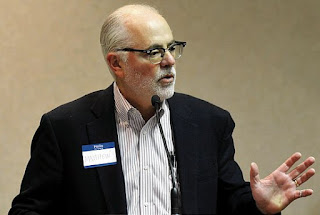 |
| Matthew Christoff |
The other day I had a Skype interview with of the 'New Emangelization Project', about evangelising men and the teaching of the Church on the father as the head of the family.
He has put the audio here - it is more than an hour long! It was an enjoyable conversation and an important topic.
I've referred to the New Emangelization website a few times; it has some useful resources, including a large collection of such interview audios (arraned in alphabetical order). Getting the views of lay Catholics - not all men - and clerics on this subject is a major part of the Emangelization project.
Support the work of the LMS by becoming an 'Anniversary Supporter'.
On causing scandal and reporting scandal
Today I am reposting this, from July 2015.
----------------------------------------------
This is not the kind of blog which goes through people's bins - metaphorically speaking - looking for scandalous accusations to make against priests, bishops, and prominent lay Catholics. Nevertheless, I do from time to time talk about events which I would rather had not happened. Events which shed a poor light on the Church, which reveal problems. I do this because persistently to ignore the things which are causing pain, sometimes great spiritual suffering, to my fellow Catholics, where these are issues on which I would be expected to take an interest or have some light to shed, would be to a failure of charity.
That's right, a failure of charity.
Here is a parallel. Suppose that you know that a child, or indeed an adult, X, has suffered emotional or physical abuse at the hands of person Y. You meet X and say nothing about Y. Y comes into the room, you greet him warmly, show him respect and deference, shake his hand, smile, and so on. He goes off again, leaving you with X, and you say nothing about it. Or, you praise Y in X's presence, you talk about all his good qualities, you say loudly how lucky we all are to have Y among us.
Have you acted with charity? No.
This is the behaviour, of which the Church has seen far too much, of complicity. It is not just a matter of taking part in a cover-up, though that might be part of it. I want to focus on the effect on the victim. What you are saying, by implication, to the victim, is: I do not take your suffering seriously; I do not want to hear about it; your hurt and anger have no place in polite society; you, the victim, should deny your own feelings, if possible even to yourself.
These people who fall among thieves - how inconvenient they are! How embarassing! The only thing to do is to pass by on the other side. To stop would be an implicit criticism of the thieves, and that wouldn't be right.
This kind of reaction from friends and acquaintances explains why victims of various forms of abuse so often do not speak out, or not for many years. The attempt to force them to deny reality is deeply unhealthy, and can even lead to mental illness.
Now, abuse can take many forms. Not all are equally serious. I have used an extreme example to establish a principle which will apply even in less extreme cases. But we can generalise. To those who have suffered in the Church, from the unjust exercise of power, we must say: you don't need to pretend everything is wonderful in the Church for us to accept you as part of our family. We won't try to make that pretence ourselves. We can talk about the problems, and perhaps even talk about ways to alleviate the suffering, and - who knows? - how to prevent it happening again.
Notice what I am not saying. I'm not saying that the victims of abuse, or their supporters, have a blank cheque to make wild accusations, libel others, use indecent language in public forums, etc. etc..
Nor am I saying that the abusers, those who have acted unjustly, should forfeit the respect due to their offices, if any, or as human beings, or that they may not themselves need our sympathy and help. In many cases their actions have arisen from their own sufferings, for which they deserve sympathy and help, and where appropriate even justice. Again, it would be inconsistent, an inconsistencly all too avidly taken up by some in authority in the Church, to throw those accused of crimes under a bus before considering the evidence.
Bloggers have a limited role, however. We don't have the resources to carry out investigations; we don't have the authority to make judgements. What we can do is report, and sometimes put together, facts which are already in the public domain. Some people would like us to stop; that's been the cry since blogs began. If that involves looking the other way when our fellow Catholics are suffering, I'm sorry but the answer is 'No'. At least from this blogger.
For those critics of blogs who are Catholic, I would ask, what part of Canon 212 don't you understand? Speaking of the laity, it tells us this.
Can. 212 §3 They have the right, indeed at times the duty, in keeping with their knowledge, competence and position, to manifest to the sacred Pastors their views on matters which concern the good of the Church. They have the right also to make their views known to others of Christ's faithful, but in doing so they must always respect the integrity of faith and morals, show due reverence to the Pastors and take into account both the common good and the dignity of individuals.
Pro scientia, competentia et praestantia quibus pollent, ipsis ius est, immo et aliquando officium, ut sententiam suam de hisquae ad bonum Ecclesiae pertinent sacris Pastoribus manifestent eamque, salva fidei morumque integritate ac reverentia erga Pastores, attentisque communi utilitate et personarum dignitate, ceteris christifidelibus notam faciant.
I've written more about clerical abuse under this label here.
Support the work of the LMS by becoming an 'Anniversary Supporter'.
What to do about Catholic marriages
Pope Francis' words about 'the great majority' of Catholic marriages being invalid have, it appears, been redacted, in the official transcript of his press conference at the Lateran on Thursday, to read 'some' Catholic marriages. Assuming that the Holy Father had a hand in this, or at least allowed it to happen, we should understand it as his second thoughts. He acknowledges, in some sense, that what he said the first time was not right, or not wise. This ought to mean that the people criticising us for disagreeing with the Pope should now eat their words, since he agrees with us in disagreeing with what he said, but I don't suppose many of them will look at it that way.
What we can all agree about is that there is a crisis of marriage. I would also like to draw out one aspect of what the Pope said, or implied, which I also agree with: that the problem is not that people simply don't know, intellectually, what marriage is, but that, deep down, that understanding is not part of them. 'They say it', the Pope says. But in some sense, they don't grasp it. The problem, then, is not, as many people have suggested, a deficiency of marriage preparation. A course of talks could catechise couples; it cannot give them a culture or virtue.
The problem is one of formation, not knowledge. That problem manifests itself not in the nullity of marriages, but in their failure.
Of course good marriage preparation would be a good idea. What would make even more difference would be if the couples made a good confession immediately before the wedding. Getting married in a state of grace is necessary to receiving the graces of the sacrament, in marriage as with Holy Communion and Holy Orders. Perhaps bringing couples to confession should be a priority for marriage preparation. What that means, of course, in the context of couples who are mostly cohabiting before marriage, is that the marriage prep. should not be about catechesis so much as about bringing about a conversion of life. Not patting them on the back and saying, we don't condemn, and anyway you are getting married now, but rather saying: if you are to form a Catholic family, you need to straighten your lives out.
Something else worth saying is that if we suspect there is a crisis of invalidity in marriage, the Church must react as she would to a crisis of invalidity with Holy Orders or Baptism: not by bewailing the problem, but by making the sacrament valid. Call in the couples and get them to go through a conditional form of marriage with the right intentions; don't just wait for them to divorce and say, oh well it was probably invalid. The fact that this option is not being discussed suggests to me that the idea of invalidity is not being used, in this debate, in a serious way, to mean what it actually means. Invalidity is not just a handy excuse to get remarried. It is a defect in a sacrament which means that it hasn't worked. If it's not worked, it's not had its good effects. In that case it should be - and could easily be - sorted out. If, that is, we care about Catholics' marriages.
Support the work of the LMS by becoming an 'Anniversary Supporter'.

